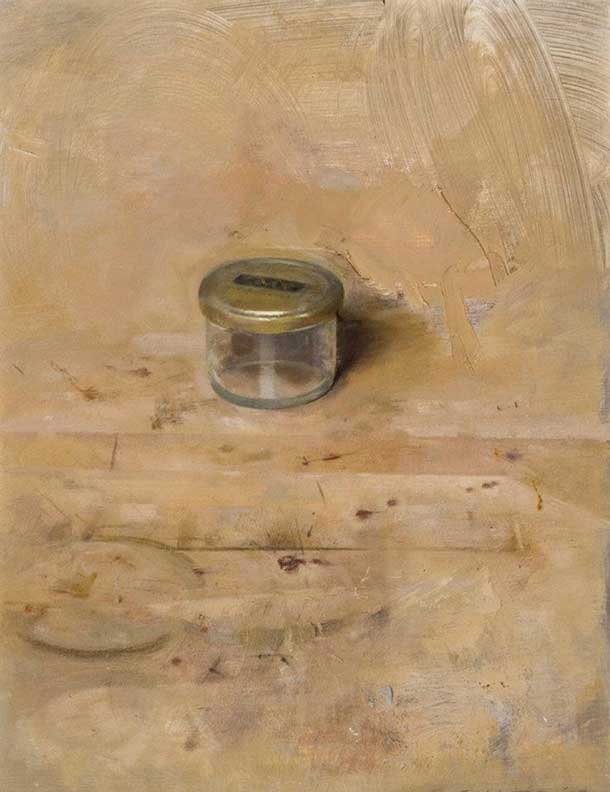
Christopher Gallego, Small Studio Jar,, 2008 12 1/8 x 8 7/8 inches
click here for a larger view
I’d like to thank Christopher Gallego for taking the time to share his thoughts on painting in our recent email interview. Mr. Gallego studied at the National Academy of Design in New York and teaches workshops in New York area. He has shown with the OK Harris Works of Art, Hirschl & Adler Modern, Seraphin Gallery, the New Britain Museum of American Art, the Brandywine River Museum, the Cincinnati Art Museum, The Naples Museum of Art, and many others. He is the recipient of fellowships from New York Foundation for the Arts, the Marie Walsh Sharpe Art Foundation, the Pollock Krasner Foundation and the New Jersey State Council on the Arts.
Larry Groff: Can you tell us a bit about your background and what lead you to become the type of painter you are today?
Christopher Gallego First, Larry, thanks very much for this interview. I was born in New York in 1959, a grandson of Spanish and Italian immigrants, and spent my formative years in the nearby suburbs. My father was an energetic painter. He never really attempted to teach or influence me in any way, but quietly hoped that I would pick it up on my own. And the strategy worked beautifully, because I took to painting soon enough and when I did it was completely my choice.
I like to describe my younger self as an introvert who craved attention. And painting was the perfect way to satisfy both personalities. It enabled me to me speak to friends, relatives and teachers, without actually being there. The visual world always had a hypnotic effect on me and it still does; I find it both stimulating and calming. So it was only natural that an atmospheric type of realism would eventually become my language of expression. My studies with the great portrait artist Ronald Sherr left me with an appreciation for the power of sustained observation.
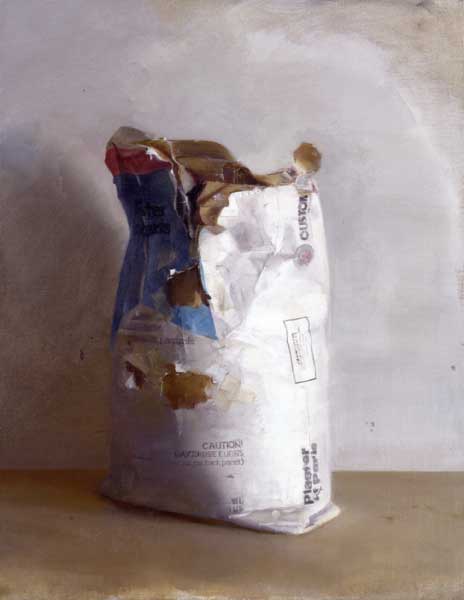
Bag of Plaster, 2000 Oil on canvas, 26 x 20 in.
LG: Please tell us about two or three painters who have been your biggest influences and why?
CG: People are often surprised to hear that my favorite painter is Morandi. That’s probably because my paintings don’t look much like his. But I love the idea of Morandi more than the look. Elevating the commonplace to the spiritual without sentiment is for me what painting is all about. I admire Edwin Dickenson very much, and Velasquez has been a lifelong hero, both for the same reason.
This may sound sacrilegious, and perhaps it is, but the truth is that I don’t look at art much anymore. Mostly I like to look at the world, the appearance of things, the light falling on things, whether I’m painting or not. I enjoy looking at the work of my peers, sometimes more than the icons of the past, because of how we share this passion yet see the world in different ways.
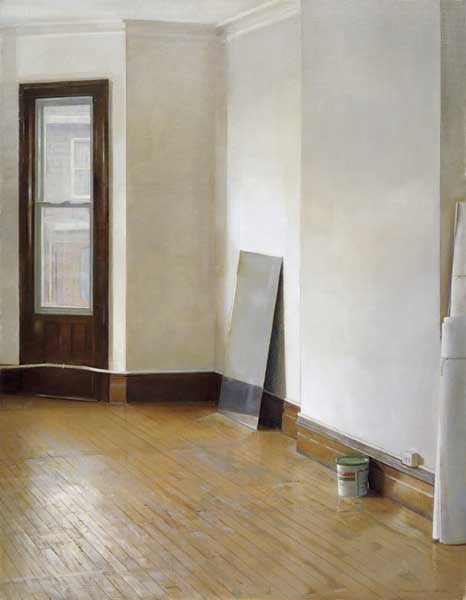
Studio Interior, 2009 Oil on canvas, 51 x 49 in.
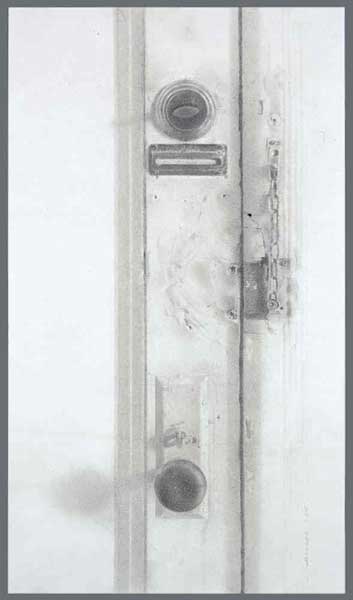
Door, Jersey City, 2006 Charcoal and graphite on paper, 21 x 12 in.
LG: I find several of your paintings and drawings evocative of the sensibilities involved with Antonio López García’s work. Any thoughts you can share with us about his work and or influence?
CG: Antonio Lopez has raised the bar on all of us. His work demonstrates that rare combination of power and sensitivity and that any subject can be transformed into art. This helped liberate me from the traditional figure painting I learned in school, and the impact, especially on my earlier work, is clear. But the work of the Spanish Master is often grand, complex and painted with an eye for distance – I’ve moved toward the intimate, the simple, and like to get right on top of things.
LG: How much does working from observation play with your work? Please tell us something about your process in painting. Do you generally build up the painting in a layered, indirect manner or do you work more directly? Any special palette or method of working other painters might find of interest?
CG: Observation is everything. At least 50% of my time in the studio is spent just staring at the subject and not making a stroke. I liken observation to making a bank deposit; the act of painting is the withdrawal. You can’t withdraw without depositing without getting into trouble. I’m full of analogies and metaphors I know, and that’s one of my favorites.
I paint directly and quite freely in the early stages, almost like an abstract artist. I like to really pile the paint on, using a palette knife for most of the work. At some point I’ll turn the corner from near-abstraction to modeling, making corrections along the way. That’s the key; I live with any errors in the drawing while fleshing out the forms, adjusting things here and there. I use a simple palette of thirteen colors, some opaque, most transparent. I love Old Holland colors and my medium is Turpenoid with stand oil, but I use very little of it. The stiffness of this paint is very compatible with knife work, though it isn’t intended for that. I like when the paint pushes back a bit.
Anyone who wishes to see my materials list may visit the “classes” page of my website

Nest, 2006 Oil on wood panel, 10 1/8 x 12 3/8 in.
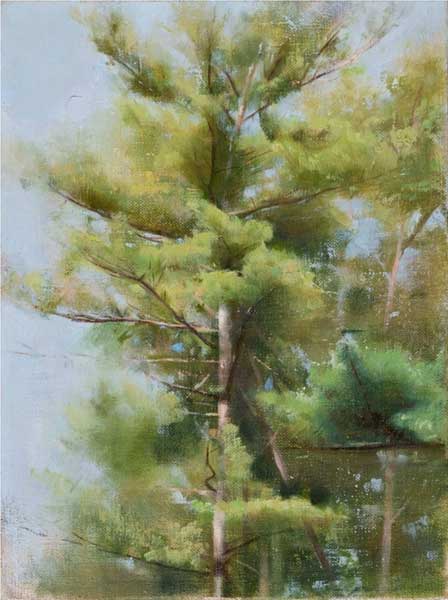
Pines, Summer, 2009 Oil on canvas, 12 x 9 in

Surf, 2011 Oil on Board, 8 3/8 x 12 in.
LG: What aspect of the act of painting excites you the most? Why are you a realist and not an abstract painter?
CG: I have a great appreciation for abstraction, but frankly, it just isn’t my language. I’ve tried it a few times, and after a half hour or so of joyful paint slinging I’m stumped by the feeling of “now what?” I need to have a subject in front of me to spur my thinking. My favorite part of the process is the refinement. Taking a painting that looks OK and pushing it way over the finish line – bringing more depth and nuance into it, manipulating the clarity, splitting hairs with values so to speak. This is the part that takes all of the energy and concentration I have. But I try not to make it laborious.
The game of painting is played on two levels. First there is the artist, making decisions, solving problems, doing the actual work. Then there is the other self that watches the artist at work, monitoring one’s own thoughts and emotions. So if I start to get bored for example, and this can be a problem for me, I’ll pick up the energy any way I can, sometimes by deliberately making a mistake. That usually gets me going. I’m always trying to stay in that sweet spot of being patient but having a slight edge.
LG: In your e-book The Art of Observation you discuss many important aspects of painting from nature. I was struck by one thing you said; “One of the hardest things for me to witness is an artist laboring over a canvas, struggling to force the work with grim determination and a good deal of sweat. Unfortunately the “no pain, no gain” approach just doesn’t work here, in fact it causes a majority of the problems…” I’ve come across some hyper-realist paintings where there’s a noticeable body odor from all this sweating. Where the extreme level of rendered details seemed to be its main reason for being.
Your thoughts here are interesting given that your richly-detailed realist work can take several months to complete. How do you keep paintings fresh and avoid looking overworked? Any thoughts you care to share about trends in contemporary hyper-realism?
CG: The work of some of today’s hyper-realists is, in my opinion, nothing short of astounding. My favorite artists however, paint more loosely than I do, and I I see myself somewhere in between the two. These distinctions don’t matter as much as the approach and the feeling of the work. But I was actually referring to my students in that quote. They work much harder than necessary and I wish they wouldn’t. Trying hard simply doesn’t work. It leads to anxiety which compromises decision-making.
It’s taken quite some time for me to arrive at the nonchalance of process you refer to. It’s a recent development; it came into being about five years ago. Many of us are taught that great achievements are the result of pain and suffering. I used to struggle like mad with my art, lose sleep over it, lament over “ruining” pieces and so on. Painting became easy the day I decided it should be easy. It was really that simple. This certainly doesn’t mean I feel I’m always successful. But the canvas is merely a reflection of the quality and depth of the observation; it has no reality in itself. This is worth repeating…the canvas is a reflection.
If I’ve grasped something visually, I can get back anything I’ve lost; if I can’t get it back; then I never had it to begin with. Knowing this brings me a contentment or rather a trust in the process, and the end result is a look that is fresher and more elegant than would be achieved by trying to force things.
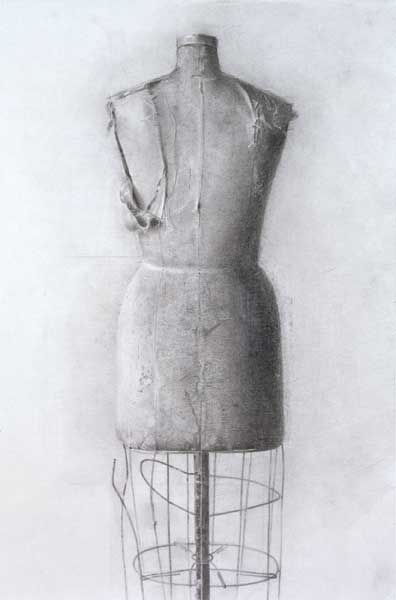
Mannequin, 1998 Charcoal and graphite on paper, 17 x 13 in
LG: Your e-book also talks about the need to paint out carefully worked details if those areas looks fragmented from the whole, calling this “pulling it together”. I’ve also heard it referred to as keeping the painting open and not being precious with the painting. This seems like a more modernist approach to painting – to keep everything open for major changes right up until the last finishing brushstroke. This seems not unlike the abstract-expressionistic manner of an all-over approach. This seems a painful concept for some painters who fear losing days or weeks of hard-won work. Often you see them take the opposite approach of protecting the fragmented areas and just building up more and more details – further shutting down the painting.
What advice can you offer about seeing the big picture, getting harmony and finding the courage to paint in an open manner?
CG: The tendency to protect is fear-based; I call it “painting defensively”. It’s helpful to remind oneself that if you’ve done something once, you can do it again. Details and masses work in concert – the masses support the details while the details assist in constructing and refining the masses. I prefer to drop a few details in place early on, knowing that they will be lost and found many times over. It’s not necessary to keep the painting open because it always is! Anything can be changed.
We’re so programmed to believe a project should move in sequential steps from start to finish, but painting doesn’t. Moving forward and backward can actually be fun, but the important thing is to keep it moving. Sometimes a mistake will lead to an insight that you wouldn’t have had otherwise, so mistakes shouldn’t be feared. Here’s my recommendation to the aspiring artist: forget about creating a work of art. Don’t get too attached to the outcome; get attached to the process. Turn this into a challenging game that will make you better in the end.
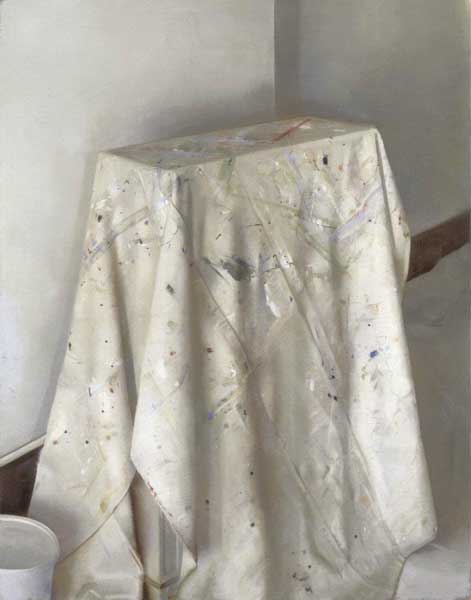
Drop Cloth, 2006 Oil on canvas, 49 x 38 1/2 in.
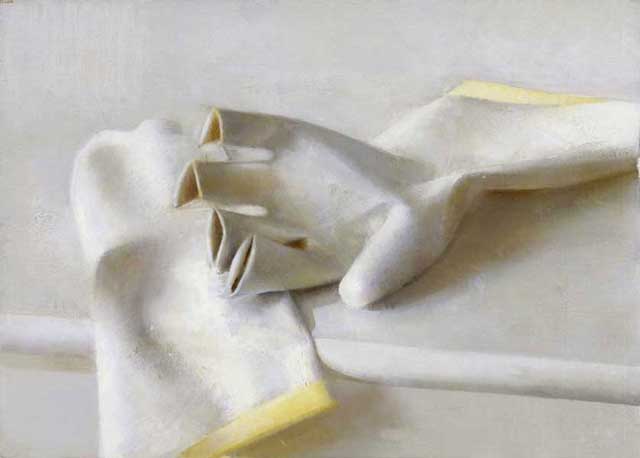
Rubber Gloves, 2005 Oil on wood panel, 8 ¾ x 12 in.
LG: Another statement from your e-book resonated with me; “I’ve noticed how inexperienced artists tend to darken things, moving down the value scale, strengthening boundaries, creating weight and solidity. Mature artists do the opposite; lightening, moving up the value scale, losing edges, making things look ethereal while maintaining clarity.”
This is very useful advice and is part of what makes good painting so engaging. People can get so hung up on making something look real that they can lose sight of the need to make a good painting. You also went on to state that:
“An awareness of the countless changes in intensity, shifts of color and fluctuations in light reveal a profound beauty in the most ordinary things. Suddenly, the world seems fresher and more alive.” Would you say that the real subject is the artist’s engagement with the motif not just making the motif look real?
CG: Yes, I totally agree with that. The engagement, or the embrace as I like to call it, is at the heart of the work.
Representation should move in several directions simultaneously, which include clarity and atmosphere. One doesn’t negate the other, they balance. Too much line and too much detail will make a piece look stiff and motionless. But the tonal changes, and there are thousands to consider – you can never paint too many of them and the work will just get richer. Sharpening up one area gives me permission to soften another. If the work gets too busy with details it can pulled it together with the method we’re talking about. Oil paint is more transparent, even the whites, than we think, so it would take a very thick layer indeed to completely obscure previous work.
Another consideration is effortlessness. It’s the most beautiful quality any art form can have. What’s the difference between a great dancer and an average one? Ease of execution, fluidity. Laboring over a work will give you just that – a labored look, which can make the viewer feel uncomfortable. It’s not just about satisfying yourself, you have to keep others in mind. You might feel proud about all that hard work you’ve done. But is the work moving, or just impressive?

Windows, 2005 Oil on canvas, 48 x 54 in.
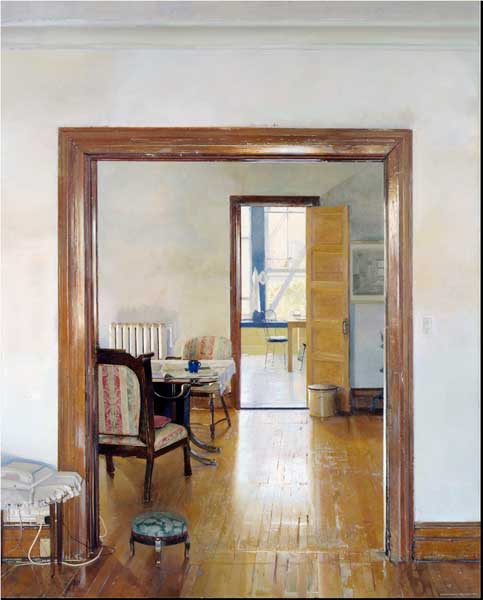
Interior with Three Rooms, 2000 Oil on canvas, 90 x 72 in.

Interior with Three Rooms, Detail
LG: In a world threatened by global warming, political and economic chaos, and the never-ending disasters of all kinds; why should painters still care about beauty?
CG: One of the things I like about my job is that I know it is not going to save the world. Because I don’t want that responsibility, it’s too much. Given all the things you mention, civilization doesn’t really need painters. And it doesn’t need poets, actors, musicians or athletes either. But how dull would life be without them? These people motivate us.
The role of visual artists and all artists, in my view, is to remind people of the extraordinary things they are capable of. I can get inspired for example watching a master pizza maker tossing and spinning the dough, casually doing something that to me seems so impossible. The joy of doing, of being in the zone with work that you love is unlike any other. The evils of the world can’t simply be eliminated and they can’t be defeated; they have to be replaced by something higher. Art is about more than the creation of beauty; it demonstrates an enthusiasm for life, which is contagious. Spreading some of that enthusiasm around is the artist’s contribution to the world.
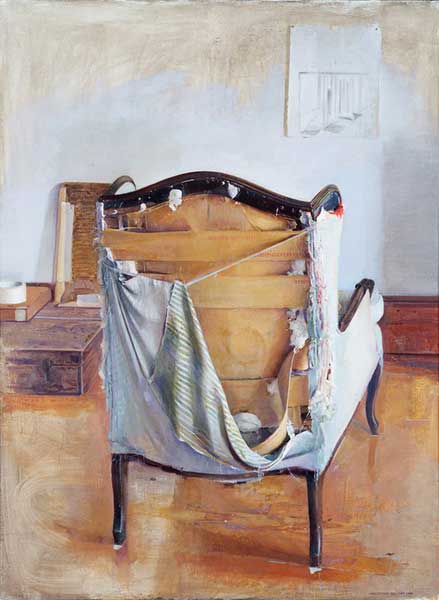
Studio Chair, 2008 Oil on canvas, 60 x 44 in.
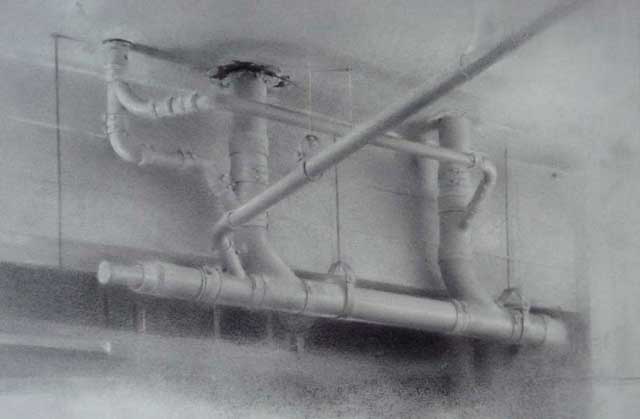
Ceiling Pipes, 2011 Charcoal and graphite on paper, 14 x 19 in.
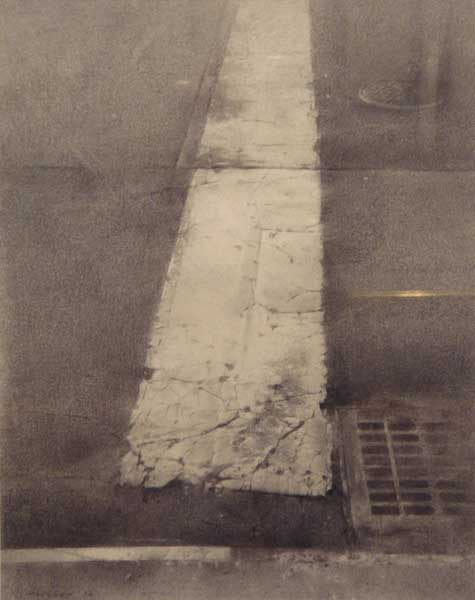
Tenth Avenue Crosswalk #2, 2012 Charcoal and Graphite on Paper, 19 1/2 x 15 5/8 in.

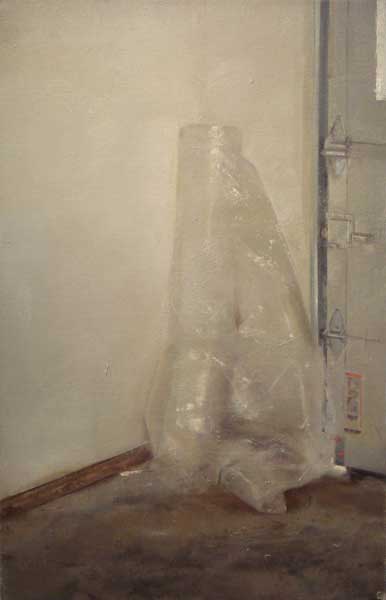
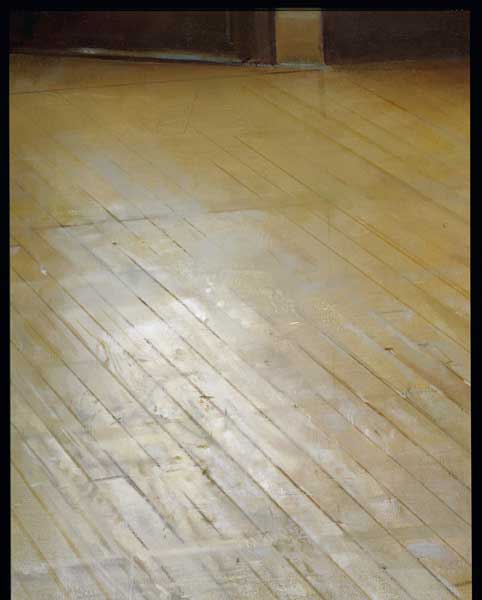
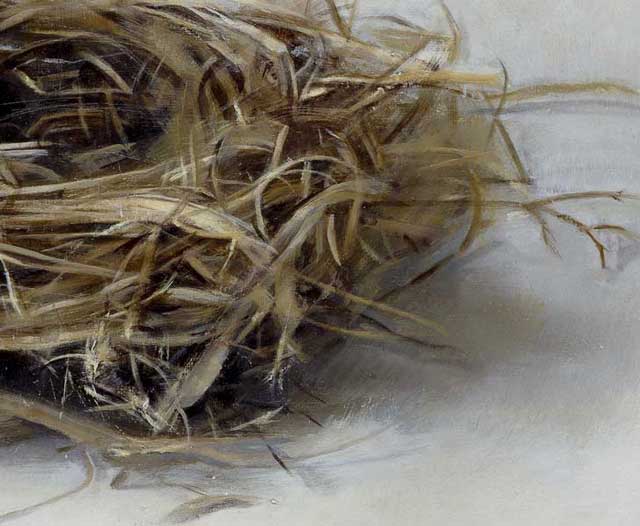
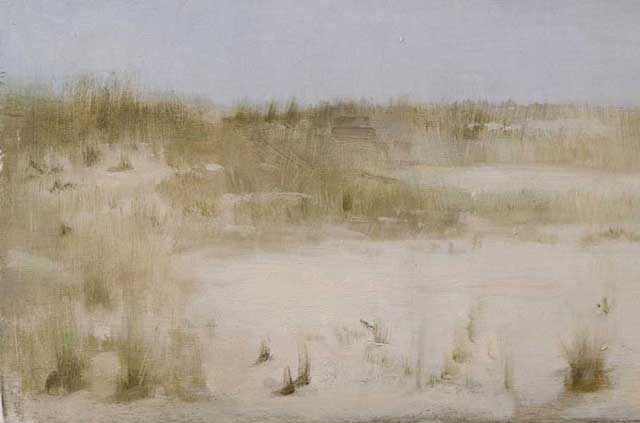
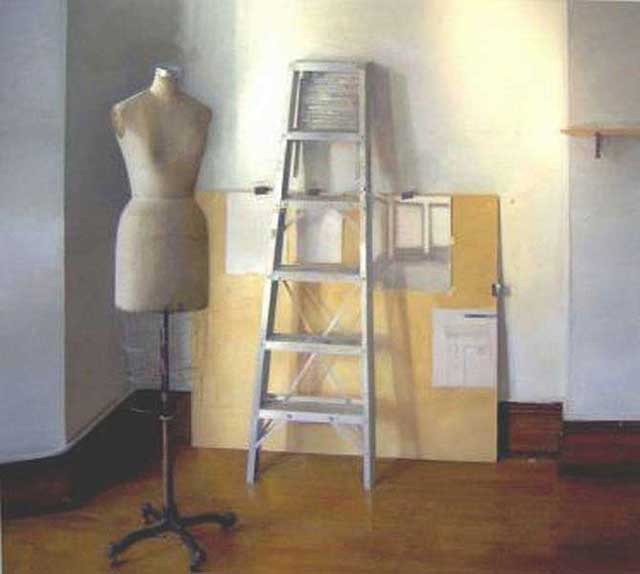
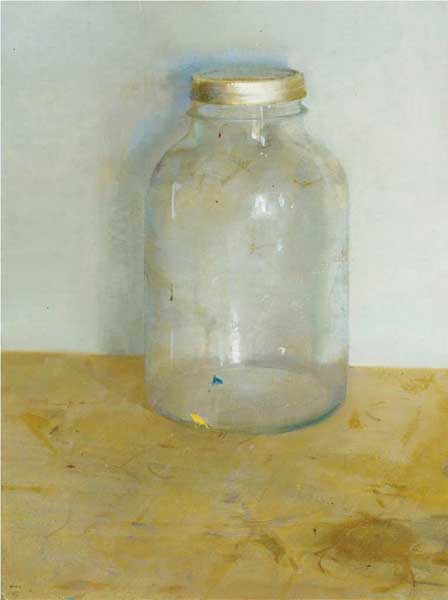





Very beautiful, quiet work. I like the paintings with the construction materials: the bag of plaster painting is sublime, as is the bird’s nest. Thanks for introducing me to this work…really great stuff!
Great work, Christopher. Great to hear you mention Morandi and Lopez Garcia. Your paintings inspire me to charge down to the studio and get to work. I have just taken on a couple of part-time students, and this interview is exactly what I needed to convey all kinds of things, about the still life in particular. Thanks to you also Larry for another galvanizing interview.
These are words of wisdom from a superb artist. The paintings of course give further credence to Christopher’s words and they are truly beautiful. The works have a calmness and confidence of an artist who has a lot of self knowledge and is very comfortable in his skin. Larry, thanks for posing such interesting questions and providing another great interview!
Wow another great interview! I love your work Christopher and am envious of your still life paintings…I struggle w still life especially background. I get all hung up on that. Thanks Larry for introducing us to Christopher!
Throughout the reading of this interview, I felt as if I am actually standing in your studio,
listening to your thought, almost thinking along with you, as if nodding my head in agreement and solidarity. Occasionally, perusing and taking in the uplifting atmosphere of your paintings.
All that is left for me to say is. Thank you.
When an artist’s thought, feeling and perception are in accord, while he or she abides in quiet, concentrated rapport with a scene, those sensibilities guiding a skillful hand will succeed in delivering upon canvas a cornucopia of visual delights and nourishing insights.
Chris, I appreciate your sharing with us such depth and detail about your working process in vivid, clear language. It is also clear from your work how determined, patient and comfortable you are during long hours at the easel.
Thank you all for reading, and for your kind remarks. What a great experience – Chris
A another great interview Larry! Thank you Christopher for some very thoughtful responses. I in particular like the idea of the canvas as a reflection of our efforts and insights. Thank you both!
Beautiful work! Thanks to you both for the elegant work and interview.
I agree with Julyan, these paintings are inspiring me to get straight into my studio. As an artist based in London, Painting Perceptions is such a wonderful source of inspiration and motivation for me as a painter, introducing me to so many artists I would never have discovered otherwise. Thank you.
Beautiful paintings, quiet and lovely – looking at them, a kind of renovation.
Robyn Gardner,
Wishart Gallery, Port Fairy, Australia
This interview is a great gift to get on a sundaymorning! The work and the interview are so truthfull and inspirational, I am glad to discover your beautiful work Christopher!
Christopher’s work has inspired me deeply and given me assurance that there is a beauty to be found in our every day surroundings. Now his thoughtul words-so beautifully narrated here-on “being artist,” excites me once again to renew my perceptions and thoughts on my own approach to art-making process. Recently I’ve had a privilege of exchaning a few words with him persoally, and my respect for him grew deeper as I learned that he was not only a great painter but also a kind and incredibly insightful teacher as well. I am grateful for the posting of this interview!
Wonderful painting, haunting images. Much enjoyed another interview on this invaluable site
Very powerful work! kind of peace about it which s very captivating.
Me encanto tu trabajo, la luminosidad que le das a las formas… estoy de acuerdo contigo que la mayoria de los artistas buscan pintar sombras……felicidades.
I just saw this for the first time, Luis. Thank you.
Could we be related?